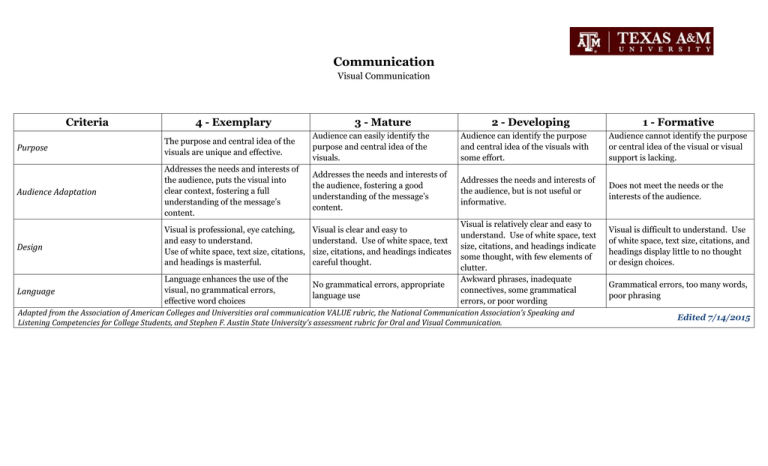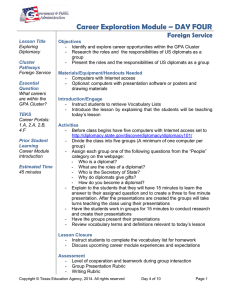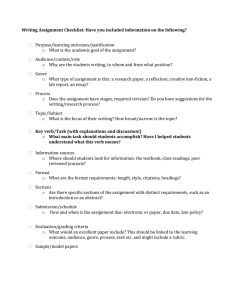Communication Criteria 4 - Exemplary
advertisement

Communication Visual Communication Criteria 4 - Exemplary 3 - Mature 2 - Developing 1 - Formative Purpose The purpose and central idea of the visuals are unique and effective. Audience can easily identify the purpose and central idea of the visuals. Audience can identify the purpose and central idea of the visuals with some effort. Audience cannot identify the purpose or central idea of the visual or visual support is lacking. Audience Adaptation Addresses the needs and interests of the audience, puts the visual into clear context, fostering a full understanding of the message’s content. Addresses the needs and interests of the audience, fostering a good understanding of the message’s content. Addresses the needs and interests of the audience, but is not useful or informative. Does not meet the needs or the interests of the audience. Visual is relatively clear and easy to understand. Use of white space, text size, citations, and headings indicate Design some thought, with few elements of clutter. Language enhances the use of the Awkward phrases, inadequate No grammatical errors, appropriate visual, no grammatical errors, connectives, some grammatical Language language use effective word choices errors, or poor wording Adapted from the Association of American Colleges and Universities oral communication VALUE rubric, the National Communication Association’s Speaking and Listening Competencies for College Students, and Stephen F. Austin State University’s assessment rubric for Oral and Visual Communication. Visual is professional, eye catching, and easy to understand. Use of white space, text size, citations, and headings is masterful. Visual is clear and easy to understand. Use of white space, text size, citations, and headings indicates careful thought. Visual is difficult to understand. Use of white space, text size, citations, and headings display little to no thought or design choices. Grammatical errors, too many words, poor phrasing Edited 7/14/2015 Communication Courses in the American History category focus on the consideration of past events and ideas relative to the United States, and involve the interaction among individuals, communities, states, the nation, and the world. Core Objectives Critical Thinking Skills: To include creative thinking, innovation, inquiry, and analysis, evaluation and synthesis of information Communication Skills: To include effective development, interpretation and expression of ideas through written, oral and visual communication Teamwork: To include the ability to consider different points of view and to work effectively with others to support a shared purpose or goal Personal Responsibility: To include the ability to connect choices, actions and consequences to ethical decision-making Definition: Visual communication is prepared, purposeful presentation and delivery of supporting visual aids, typically relative to oral communication and intended to benefit or amplify an audience’s understanding of a central message or purpose. Framing Language: Visual communication takes many forms. This rubric is specifically designed to evaluate visual communication that takes place in conjunction with an oral presentation of a single speaker. Visual communication is facilitated through such media as poster presentations, power point presentations, video presentations, among others available and appropriate to specific disciplines and classroom experiences.


